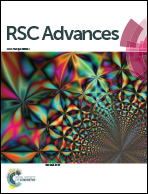Specific interaction of platinated DNA and proteins by surface plasmon resonance imaging†
Abstract
The DNA-targeting platinum complex cisplatin is one of the most successful drugs for clinical treatment of solid tumors, and several new analogues of transplatin have shown cytostatic activity recently. The specific recognition of platinated DNA with cellular proteins is of great interest for better understanding of the pharmaceutical mechanisms. Herein, a surface plasmon resonance imaging (SPRi) method to differentiate the interaction between the protein human high mobility group box 1 (HMGB1) and DNAs, and human nuclear protein positive cofactor 4 (PC4) and DNAs has been developed. Four kinds of DNAs were immobilized on the gold films including platinated-DNA adducts (cisplatin and trans-[PtCl2(NH3)(thiazole)] (trans-PtTz) damaged DNAs; referred to as cisPt–DNA1 and transPtTz–DNA2, respectively) and native DNAs (DNA1 and DNA2, as controls). The validation of the method has been proven by the specific recognition of HMGB1 and cisPt–DNA1 first. The results obtained indicated that the PC4 was more likely to bind to platinated DNAs (cisPt–DNA1 and transPtTz–DNA2) than the native DNAs. Temperature-dependent kinetics and thermodynamics revealed that the recognition behavior was not affected by a temperature changefrom 15 °C to 42 °C. This label-free method provides authentic results, as the controls can be simultaneously determined by a single chip under the same conditions, and this makes it suited for other high throughput analyses of interactions between drug-damaged DNAs and proteins to better understand the activity/inactivity mechanisms of drugs and drug screening/discovery.


 Please wait while we load your content...
Please wait while we load your content...